Accurate Miniatures 1/48 F-6A Mustang
The Airplane:
Everyone "knows" that the Mustang was the airplane designed and built in 120 days for the British because North American's Dutch Kindelberger didn't want to build Curtiss P-40s under license, and that the first Mustangs were a disappointment because they were hobbled by the godawful Allison engine, and that the airplane only became "good" when it was powered by the mighty Merlin. Right? That's the stuff in all the Mustang books, isn't it?
Well, yes, all that is in the "history books," many of which are written by people who prove the old saw that if you copy from one it's plagiarism, while if you copy from many it's research; and if the many have copied from each other, mistakes can indeed become "facts." (The most recent of these is titled: “Wings of War” and should be ignored) We are only now, 80 years after the events, starting to discover that a lot of what was written as history at the outset was "uninformed" to be generous, and then was copied by those who followed, to the point that it became "the truth" because it had been repeated so many times.
So far as the Allison-powered Mustang being a "disappointment" is concerned, Southern California aviation legend the late Rev. B.C. Reid - who flew every kind of Mustang there was with the 107th Tac Recon Squadron of the 67th Tac Recon Group during 1943-45 - told me that the Allison Mustang was to the Mustang series what the Bf-109F was to Messerschmitt's fighter: the best combination of engine and airframe for flight harmony. "After the A-model, they kept adding weight more than they added power," he once told me, "and the D-model was an underpowered truck in comparison with the A-model. Its only grace was it could fly high." In terms of performance, when an RAF Mustang IA was test-flown against a captured Fw-190A, there was little to choose between the two up to 23,000 ft. and the Mustang could outrun the Focke-Wulf below 15,000 ft.
After the RAF ordered the Mustang I and the USAAF got around to testing the two examples that had been provided to Wright-Patterson (where they were ignored for six months), the USAAF ordered a version armed with four 20mm cannons as the P-51; 55 of which were taken from the Lend-Lease order for the Mustang IA for the RAF. After being tested in the tactical reconnaissance role the RAF was using their Mustangs in, the airplanes were modified for the Tac-R role, where they were initially known as “P-51/Tac-R,” the F-6A designation only showing up in 1944 and never used in the field.
The USAAF sent 35 P-51/Tac-R Mustangs to North Africa in 1943, where they equipped the 111th Tactical Reconnaissance Squadron (formerly the 111th Observation Squadron from the Texas National Guard). The squadron began re-equipping in March 1943 and was declared operational in May, just in time to not see use in the North African campaign.
The Mustangs found lots of use in the Sicilian and Italian campaigns. The survivors were only retired from active service beginning in the summer of 1944, and two stayed with the squadron until April 1945.
Pretty good for a “disappointment.”
The Kit:
Accurate Miniatures first releases way back in 1995 were the three Allison-engine P-51s, the P-51, P-51A and A-36. The P-51 and P-51A were both re-released in RAF markings. When the original company went bankrupt and was bought by a new group, they managed to become known by modelers as “Inaccurate Miniatures,” due to their hit-and-mostly-miss re-releases of the kits. After they went bankrupt, the molds have been licensed for production by other companies, most recently Italeri.
This particular kit, an “Inaccurate Miniatures” release as the F-6A Tac-R Mustang, was discovered at the LHS Estate Sale.
I had received the new Czechmaster resin cockpit and radiator detail sets, so I decided to use them in this project.
Construction:
Since the resin parts were used in the fuselage, this was the main area of work.
I first cut out the waste gate area from the fuselage parts, then glued each nose part to the relevant fuselage half before proceeding.
The Czechmaster Resin cockpit is basically a re-pop of the old Squadron True Details cockpit that is now made of unobtanium. Unfortunately, they made one change from that set that is nearly fatal: the cockpit floor part is not thin as it should be. One can only use that if you were to cut out the center of the gear wells in the wing. I ended up using the plastic floor, which fit fine and allowed me to proceed. This cockpit is a good upgrade for detail over what's in the kit.
The resin radiator shows how different that was from the later Merlin Mustang radiators. It fits easily, but I discovered when the model was finished that with the resin waste gate opened to what was the maximum, it's very difficult to see anything inside.
This is one of those sets best used by the “I don't care if I can't see it, I know it's there” modelers.
The rest of the assembly was very straightforward. If you exercise care in this process, you can have the model assembled without need of filler anywhere.
I decided to close up the cockpit since the plastic was clear enough to see the interior.
Painting and Decals:
I went for a “sun-faded” look on this. I first painted the yellow stripes on the wings and masked them off, since the decals for this aren't really much good. I then painted the model with Tamya XF-81 RAF Dark Green, which is a match for early war “green base” OD-41, which I then lightened with increasing amounts of light grey when I went back over the model to “fade” the paint. The lower surfaces were painted with Tamiya XF-53 “Neutral Grey.”
The decals went on without problem. You may note that the serial number that is “overmarked” with the later insignia and the ID letters is the same for both sides. This bothered me enough to use other decals to make the number right, then apply the insignia and ID letters over it. The result wasn't really worth the effort, since you are highly unlikely to notice that unless you are a fanatic for markings.
I attached the wheels and prop and cannon barrels and declared things done.
Overall:
There's a reason why these kits keep getting re-released now going on 28 years since they first appeared: they're good. No one else has done the Allison Mustang. The kit benefits from upgrades like the resin cockpit, and the Squadron vacuform canopies can still be found for reasonable prices on eBay.
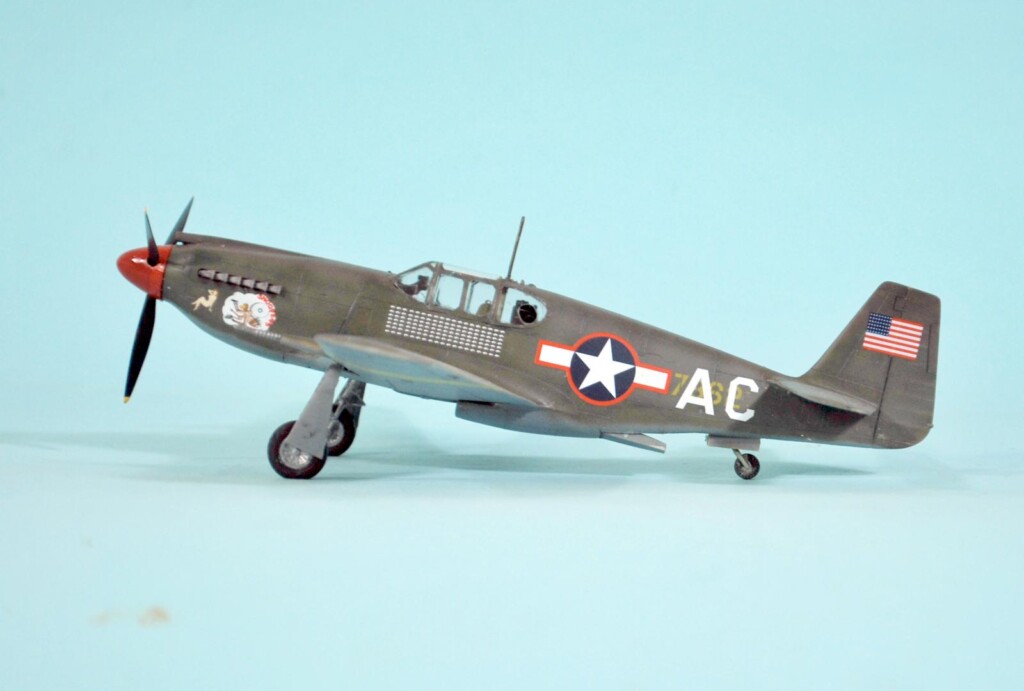
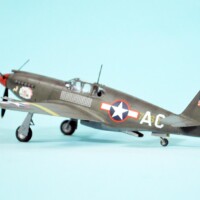

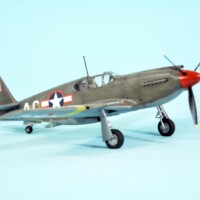
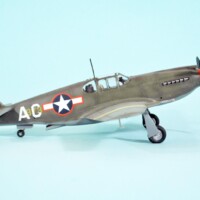
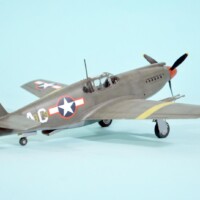
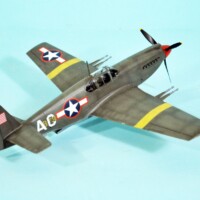
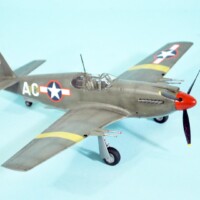
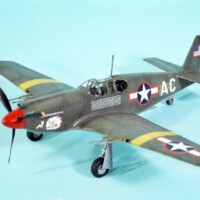
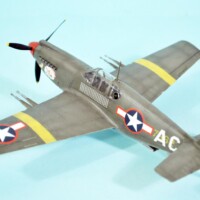
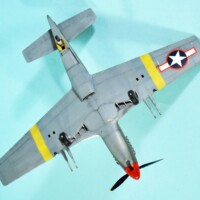
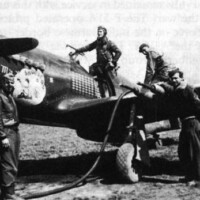
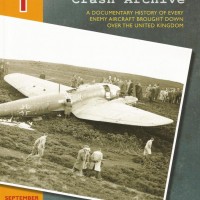
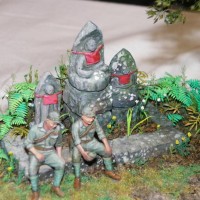
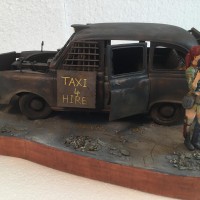
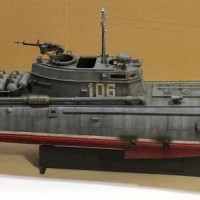
I love an Allison Mustang, it got a bad rap because of altitude performance. [as did the P-40]
Very nice, early Mustang. I may have this one in the stash. I always check to see if you have built one first, that way I know what to expect.
Enjoyed seeing the POF A-model fly.
Very nice indeed Tom; especially the finish. I've done two of these & would happily do another if it came my way. I recollect that the only things I did extra were to use a spare Tamiya windscreen sections as I thought they just looked a bit sharper & to thin down the prop blades. Appreciate your comments about research etc, too.
I used the deHavilland prop from an Eduard Spitfire kit here. TLAR to me!
Excellent result on this Mustang, Tom @tcinla
Especially the finish of it is really great.
Thanks for the supporting article and for presenting your progress in the building thread.
Another fantastic model and ditto article, Tom! How nice to read the actual facts of a plane!
Nice model Tom and right on the button regarding the Allison engined Mustangs.
Another myth is that regarding the apparent lack of long range escorts for B17's early in the war over Europe.
Hap and the rest of the bomber mafia made sure of that...until the disasters over Schweinfurt, but I digress.
Actually (from the research I did for the coming "Clean Sweep" this May), the USAAF was well aware of the need for escorts, from reports by US observers of the Battle of Britain. The 1st, 14th, 78th and 82nd FGs equipped with P-38s were supposed to become the long range escorts of the VIII Bomber Command in the fall of 1942, but were diverted to North Africa when that suddenly became an operation. The P-38s were in short supply with everyone wanting them and North Africa getting priority, so the VIII Fighter Command got the next-best fighter, the P-47. Which had no range, but VIII Technical Command began working on that as soon as the fighter arrived in England. While there were some "the bombers will always get through" types in the upper reaches of the USAAF, the myth that everybody believed in the "self-defending bomber" is that - a myth (like much of the rest of AF "history"). The problem with getting escorts was the problem of getting things organized. The Schweinfurt-Regensburg and Second Schweinfurt disasters made that obvious. Also obvious is the fact that while Rolls-Royce was fitting Merlins to Mustang Is, NAA was fitting a Merlin to the second Mustang sent to the USAAC.
You'll enjoy the coming book, since it is Actual History rather than republication of previous mistakes.
That's a superb model Tom. The supposed 'experts' did indeed downgrade an extremely capable fighter for an attribute which wasn't relevant to most air combat or mission profiles.
Nice job, Tom!
Beauty Tom
Great model with great info Tom. Always good to read about subjects from some one who loves the subjects 👍
Nicely done Tom, I've built several AM Allison Mustangs and always enjoyed building them. Only flaw is that coke bottle thick canopy and no option to poise it open. Good looking pony.
For some reason, this later release kit had better glass than the original kits. The best alternative is the Squadron vac canopy, which can still be found on eBay.
Nice work on this Tom. @tcinla I agree the Allison engine P-51 could run rings around a D model below 15.000 ft. The engine and supercharger combination made it a low level fighter. It's interesting that the D version was never criticized for being a sub par performer a lower altitudes as the A model was for for its lower performance at higher altitudes.
Another good one Tom @tcinla.
Nice build and I love the subtle paint fading on top. Happy to say that I built all the Allison Mustangs as they became available, no regrets! As always, I like your history lessons.
Nice work, Tom. Allison Mustangs are the most interesting of the breed to me.
another nice one! I love the fast-back Ponies more than the other models.
Great looking Mustang. Did you sand down the kit propeller blades or did you use a set from a different kit?
Tom, Great job on the build and overall finish. A really nice looking F-6 Mustang! Nice to see that you corrected the propeller.